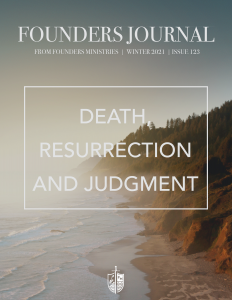31:2. At the last day, such of the saints as are found alive, shall not sleep, but be changed; and all the dead shall be raised up with the selfsame bodies, and none other; although with different qualities, which shall be united again to their souls forever.
(1 Corinthians 15:51, 52; 1 Thessalonians 4:17; Job 19:26, 27; 1 Corinthians 15:42, 43)
31:3. The bodies of the unjust shall, by the power of Christ, be raised to dishonour; the bodies of the just, by his Spirit, unto honour, and be made conformable to his own glorious body.
(Acts 24:15; John 5:28, 29; Philippians 3:21)
Second London Confession, 31:2–3
It was a cold, gray February afternoon when we buried my grandfather. The ground was still muddy from the snow that had melted earlier in the week. Every tree was bare. The small crowd under the tent shivered against the cold as the national guard officers folded the American flag they would present to my grandmother. But into the sorrow, the gathering of family members and friends read the Apostle’s Creed from the tiny bulletins issued to them by the Methodist minister: “…I believe in the forgiveness of sins, the resurrection of the body, and the life everlasting, Amen.” I was struck by the power of that ancient Christian confession against that bleak backdrop. It was also struck by how few funerals I attend ever even mention the hope of bodily resurrection.
In most funerals I attend, and in most popular discussions about death I observe, the focus of the Christian hope falls almost exclusively on what theologians call “the intermediate state:” the promise that upon death, the believer’s spirit leaves the body behind to dwell in the presence of Jesus in heaven. On the one hand, this emphasis is perfectly reasonable, since it is the immediate hope of all the saints who die before the Lord’s return. We are right to celebrate Jesus’ assurance that, “Today you will be with me in Paradise.” (Luke 23:43) We rejoice that “the spirits of the righteous” are now “made perfect” in the heavenly assembly (Heb 12:23) . We find unspeakable comfort in the truth that to be away from the body is to be at home with the Lord, that for the believers, to die is gain, and that it really is better by far to depart and to be with Christ (2 Cor 5:6; Phil 1:21, 23).
But while our immortal spirit’s reception into heaven is the believer’s immediate hope, the Bible teaches that it is not our ultimate hope. As wonderful as the intermediate state will be, it is, well, intermediate. An even greater future awaits the people of Jesus! A hope even richer, more thrilling, more satisfying. It takes the whole story of the Bible to understand this audacious Christian confession: I believe in the resurrection of the body.
“To the dust you shall return”
The Bible’s first two chapters map out God’s design for human life: embodied human beings made in his image, living forever in fellowship with him in a perfect, physical creation. This, God says, is “very good.” (Gen 1:31). But by Genesis 3, the rebellion of those image-bearers has destroyed God’s beautiful design. Sin’s consequences are not only spiritual and moral, but physical: the once-submissive creation now rebels against its former caretakers, and bodily life is now marked by pain, sickness, weariness, and, ultimately, death. The man formed from the dust, made to live forever in face-to-face fellowship with God, must now return to the dust (Gen 3:19). The relentless recitation of the deaths proceeding from Adam in Genesis 5 bears grim witness to the awful wages of sin, and to the unyielding truthfulness of God’s Word: “in the the day that you eat of it, you will surely die (Gen 2:17; Rom 6:23).”
These opening acts in the biblical drama remind us that there is nothing “natural” about death. Death instead is an “enemy” (1 Cor 15:26), a sinister intruder on God’s good design for human life. The Genesis patriarchs wept over the bodies of their dead loved ones for good reason (Gen 23:2), and so do we. All human beings—whether they affirm the Bible’s account of reality or not—instinctively know that death is not the way it was meant to be. I can see it in the “gone but not forgotten” memorial decals on the pickup trucks in my hometown. You can sense it in the feverish attempts to stave off the aging process in fitness centers and cosmetic products. I can hear it in the quavering voice of the old bluegrass singer Ralph Stanley, pleading: “O death, won’t you spare me over til another year, won’t you spare me over til another year…”
The apostle Paul tells us that these are all so many manifestations of creation’s “groaning” under the unnatural curse of death; we long to be “set free from [our] bondage to corruption (Rom 8:21).” But will anyone hear these groans? Can anyone deliver us from death?
“…those who sleep in the dust of the earth shall awake”
Yes! Standing in the ruins of Eden, God not only pronounces judgment, but promises salvation: “I will put enmity between you and the woman,” God tells the Serpent, “and between your offspring and her offspring; he shall bruise your head, and you shall bruise his heel.” (Gen 3:15). God did not disclose the details of his plan, but he made it clear that he would one day restore the beautiful kingdom our sin had destroyed, and deal with the awful curse of death itself.
For the rest of the Old Testament, God’s people cling to the persistent, if shadowy, hope that Yahweh would overcome death for them. One catches the patriarchs’ hope beyond the grave in their insistence on securing burial plots in the land of promise (Heb 11:22). We hear it also in Job’s confession that, “after my skin has been thus destroyed, yet in my flesh I shall see God, whom I shall see for myself, and my eyes shall behold, and not another…” (Job 19:26–27)
The prophet Isaiah foresaw a day when the Lord would spread a feast for his people on Mount Zion, and “will swallow up on this mountain the covering that is cast over all peoples, the veil that is spread over all nations. He will swallow up death forever; and the Lord God will wipe away tears from all faces, and the reproach of his people he will take away from all the earth, for the Lord has spoken (Isa 25:6–8).” Near the end of the Old Testament, Daniel articulates God’s coming victory over death explicitly in terms of a bodily resurrection: “And many of those who sleep in the dust of the earth shall awake, some to everlasting life, and some to shame and everlasting contempt. And those who are wise shall shine like the brightness of the sky above; and those who turn many to righteousness, like the stars forever and ever (Dan 12:2–3).” By the time Jesus comforts Martha at the grave of Lazarus, it seems Daniel’s expectation has taken hold among God’s people: when Jesus tells Mary that “your brother will rise again,” Martha immediately responds “I know that he will rise again in the resurrection on the last day.” (John 11:23–24)
One thing this brief survey indicates is that, the saints of old longed for more than a strictly spiritual “life after death.” Rather, they looked forward to the complete undoing of death, in a glorious, bodily resurrection at the end of history. They did not know that before that could happen, Someone would first blaze a trail through death, right smack in the middle of history.
“In him was life”
From the beginning of his ministry, Jesus seems intent on nothing short of abolishing death (2 Tim 1:10). Beyond his seemingly endless reversals of leprosy and other terminal illnesses, Jesus repeatedly disrupts the funeral services of unsuspecting mourners. From the widow of Nain’s son (Luke 7:11–17), to Jairus’s daughter (Mark 5:35–43), to his friend Lazarus (John 11:38–44)—Jesus with only a mere word reaches into the realm of death to retrieving its prey. There was precedent for miraculous healings, and even resurrections, in the ministries of Elijah and Elisha, but Jesus’ sheer audacity in the face of death is entirely new. He bullies death. He takes for himself the brazen title, “the resurrection and the life” (John 11:25–26). He makes the staggering claim that one day “all who are in the tombs” will hear the sound of his voice and come out to give an account to him (John 5:28–29). Never had anyone spoken like this man! (John 7:46)
But all of this is made to seem like just a sad delusion when Jesus succumbs to the curse of death himself. After an agonizing and humiliating crucifixion on Good Friday, the one who called himself “the Life” (John 14:6) is rendered a “corpse (Mark 15:45).” The dead body of Jesus is wrapped in burial clothes, anointed with spices, bathed in tears, and sealed in a tomb—presumably to return to the dust like every son of Adam before him. Yet there were also hints that, even in his violent death, “the Life” was still lurking—from his strangely victorious cry before his final breath (John 19:30), to the rending of the Temple curtain, to—least explicable of all!—the opening of the tombs of the Jerusalem saints (Matt 27:52–53)! Improbable as it seems, could it be that Jesus’s own death was in fact his own master strategy to empty the graves of God’s people once and for all?
Of course, this is precisely what his followers discovered to be true on Sunday morning. The tomb of Jesus had been vacated, his discarded grave clothes neatly folded and left behind (John 20:6–7). “Why do you seek the living among the dead?” the angels asked, “He is not here, he is risen, just as he said.” (Luke 24:5–6) Over the next forty days, the risen Jesus would himself appear to more than five hundred of his followers(1 Cor 15:6). As they heard his voice and touched his flesh, it was clear that this was the same Jesus they had known and loved before. “It is I myself,” Jesus assured them. (Luke 24:39) Yet Jesus was also unmistakably different. His resurrection wasn’t like that of Lazarus, or Jairus’s daughter, who returned from death the same, only to die again later. Jesus had passed into an entirely new state. His body, subject to ordinary limitations during his earthly ministry, now had amazing, supernatural properties: he appeared and vanished at will; he could pass through grave clothes, a sealed tomb, and locked doors. As Jesus would explain, he had not simply “survived” death; he had broken death (Rev 1:18).
And he had done it for them.
“Swallowed up by Life”
The apostle Paul helps us connect Jesus’s resurrection to our own future hope. Now ascended to God’s right hand, the risen King Jesus will one day return to us; when he does, he will transform our bodies to be just like his on that first Easter morning. “But our citizenship is in heaven,” he reminds the Philippians, “and from it we await a Savior, the Lord Jesus Christ, who will transform our lowly body to be like his glorious body, by the power that enables him to subject all things to himself.” (Phil 3:20–21)
This transformation our bodies will undergo will be like that of a seed that has been buried in the ground. A seed goes into the soil as a bare kernel, but it bursts forth at harvest as a beautiful, golden shaft of wheat! It is the same seed you left covered in dirt, but its transformation leaves it almost unrecognizable! In the same way, these mortal bodies of ours will one day go into the ground, completely used up and expired. But on resurrection morning, Jesus will raise that same body in an entirely new condition: “What is sown is perishable; what is raised is imperishable. What is sown in dishonor; it is raised in glory. It is sown in weakness; it is raised in power. It is sown a natural body; it is raised a spiritual body.” (1 Cor 15:42–44)
What assurance this gives us as our fallen physical bodies ache and age, get sick and grow weak. Paul compared life in these bodies to living in a “tent”—fragile, uncomfortable, temporary living quarters. In these tents, we often “groan,” longing for better, stronger, more permanent bodies. But instead of giving our hearts to bitterness, self-pity, or despair, Christians look with confidence to the resurrection bodies Jesus has promised us:
For we know that if the tent that is our earthly home is destroyed, we have a building from God, a house not made with hands, eternal in the heavens. For in this tent we groan, longing to put on our heavenly dwelling, if indeed by putting it on we may not be found naked. For while we are still in this tent, we groan, being burdened—not that we would be unclothed, but that we would be further clothed, so that what is mortal may be swallowed up by life. He who has prepared us for this very thing is God, who has given us the Spirit as a guarantee. (2 Cor 5:1–5)
This new body is the destiny of every believer, even if we are still living at the Lord’s return. “We shall not all sleep,” Paul tells the Corinthians, “but we shall all be changed.” Jesus will outfit all of his people with a body like his, that can sustain the glory and joy of eternal life in a world made new. When the last trumpet sounds and the dead in Christ rise, those still alive will experience “the perishable putting on the imperishable,” and “the mortal putting on immortality.” It will be the work of a moment when Jesus appears—“in the twinkling of an eye”—but at the arrival of King Jesus, death will forever be swallowed up by life (1 Cor 15:50–55).
With this “great change” accomplished, we will at last know that unbroken reunion between Christ and his people that our hearts ache for in this life. As we together rise to meet the Lord, we know that all the “former things” that parted us before have now “passed away.” All things have now been made new, and “we will always be with the Lord. (1 Thes 4:14–17; Rev 21:1–4)
The hope of bodily resurrection makes the “committal,” or graveside service of a believer into a sacred moment of worship and gospel proclamation. Here, we remind each other that Christians are right to grieve for their loved ones who have died in the Lord, as Tabitha’s friends did for her (Acts 9:39). But we do not grieve without hope, as the world does (1 Thes 4:13). Instead, our hearts brim with confident expectation at the graves of our brothers and sisters. We have not abandoned them to the ground; we have planted a seed that Jesus is coming to raise up new, beautiful, and permanent. Our relationships have not been permanently severed; their bodies have “fallen asleep in the Lord,” and on resurrection morning, Jesus is coming to wake them up. Through a Savior whose love is stronger than death (SOS 8:6), they will rise again, and so will we. And so we will always be with the Lord.
“Then comes the end”
The Bible’s grand story is not complete without the bodily resurrection of God’s people. It is blessedly true that the spirits of our loved believers who die before the return of Jesus will immediately be welcomed into his blessed presence upon death. But Jesus did not come merely to provide a detour around death for his people. He came to destroy death. To do this, Jesus invaded the tragic story of the first Adam as a “Second Adam,” a hero come to reclaim all that the first Adam lost of his Father’s “very good” world in the beginning. That mission remains unfinished so long as that sneering enemy, Death, claims the body of even one of his people. That is why the grand finale of Jesus’ victory will be the destruction of Death in the glorious, bodily resurrection of all who belong to him:
But in fact Christ has been raised from the dead, the firstfruits of those who have fallen asleep. For as by a man came death, by a man has come also the resurrection of the dead. For as in Adam all die, so also in Christ shall all be made alive. But each in his own order: Christ the firstfruits, then at his coming those who belong to Christ. Then comes the end, when he delivers the kingdom to God the Father after destroying every rule and every authority and power. For he must reign until he has put all his enemies under his feet. The last enemy to be destroyed is death. For “God has put all things in subjection under his feet.” But when it says, “all things are put in subjection,” it is plain that he is excepted who put all things in subjection under him. When all things are subjected to him, then the Son himself will also be subjected to him who put all things in subjection under him, that God may be all in all. (1 Cor 15:20–28)
The scene Paul describes is breathtaking. Before the world began, God’s Son had accepted a dangerous and costly assignment from his Father: to rescue sinners and reclaim his Father’s world, no matter the cost (John 17:1–5). On other side of that completed mission, the Lord Jesus now stands before his Father in the company of all his redeemed, resurrected people. Every promise has been kept. Every enemy has been vanquished. Not one sheep is missing. All things are now in subjection to him, the world’s rightful ruler. Then, shining like the sun, we will watch in awe as that faithful, noble Son presents it all as a gift of love to his Father. I don’t know exactly what it will feel like in that moment when “God is all in all.” But I think it may be something like what C. S. Lewis tried to capture at the conclusion of his Narnia stories:
And as He spoke . . . the things that began to happen after that were so great and beautiful that I cannot write them. And for us this the end of all the stories, and we can most truly say that they all lived happily ever after. But for them it was only the beginning of the real story. All their life in this world and all their adventures in Narnia had only been the cover and the title page: now at last they were beginning Chapter One of the Great Story which no one on earth has read: which goes on for ever: in which every chapter is better than the one before.






















